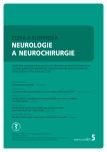Myxovirus Resistance Protein A in Interferon-β Therapy in Patients with Multiple Sclerosis and Treatment Effectiveness Monitoring Algorithm
Authors:
J. Libertínová 1; E. Meluzínová 1; E. Havrdová 2; D. Horáková 2; I. Kovářová 2; E. Hynčicová 1; P. Lišková 1; E. Houžvičková 1; V. Maťoška 3; M. Zajac 4; A. Tomek 1; M. Bojar 1; P. Marusič 1
Authors‘ workplace:
Neurologická klinika 2. LF UK a FN v Motole, Praha
1; Neurologická klinika a Centrum klinických neurověd, 1. LF UK a VFN v Praze
2; Laboratoř molekulární diagnostiky, Nemocnice Na Homolce, Praha
3; Ústav lékařské mikrobiologie, 2. LF UK a FN v Motole, Praha
4
Published in:
Cesk Slov Neurol N 2016; 79/112(5): 547-551
Category:
Original Paper
Overview
Introduction:
Interferon-β (IFNβ) is the first-line treatment for relapsing-remitting multiple sclerosis. Myxovirus resistance protein A (MxA) is considered to be an IFNß bioactivity marker. Responsiveness to the IFNß treatment may be reduced by neutralizing antibodies (NAbs).
Material and methods:
We investigated the presence of NAbs and mRNA MxA expression in a group of patients who had started IFNß treatment. mRNA MxA was measured with real-time PCR every three months. MxA induction was performed in patients in whom continuous decline was detected. NAbs were determined using the cytopathic effect method every six months. Patients were regularly observed clinically and with MRI.
Results:
119 patients were included, 99 completed the observation period of 24 months. NAbs positivity was observed in 17 patients, mostly in month 12 and 18. NAbs positivity was permanent in ten patients (10%). Nabs titre of 20–100 TRU/ml was associated with a decline in MxA levels under the cut-off in 85% of cases, and in all patients when Nabs titre exceeded 100 TRU/ml. Permanent MxA decline was seen in 19 patients – in all 10 patients with permanent NAbs positivity, in three patients with transitional NAbs positivity and in six patients without NAbs. The MxA induction was insufficient in all permanent NAbs positive patients and in two patients with isolated MxA decrease and without NAbs. MxA decrease preceded NAbs positivity in 40% of cases.
Conclusion:
MxA becomes the main laboratory marker of IFNβ efficacy as it can indicate patients at risk of IFNβ efficacy loss, even in situations when patients produce NAbs. MxA induction is necessary to verify IFNβ efficacy.
Key words:
interferon-β –MxA induction test – myxovirus resistance protein A – neutralising antibodies – multiple sclerosis
The authors declare they have no potential conflicts of interest concerning drugs, products, or services used in the study.
The Editorial Board declares that the manuscript met the ICMJE “uniform requirements” for biomedical papers.
Sources
1. Loleit V, Biberacher V, Hemmer B. Current and future therapies targeting the immune system in multiple sclerosis. Curr Pharm Biotechnol 2014; 15 (3): 276–96.
2. Hesse D, Sorensen PS. Using measurements of neutralizing antibodies: the challenge of IFN-beta therapy. Eur J Neurol 2007; 14 (8): 850–9.
3. Bertolotto A, Granieri L, Marnetto F, et al. Biological monitoring of IFN-β therapy in multiple sclerosis. Cytokine Growth Factor Rev 2015; 26 (2): 241–8. doi: 10.1016/j.cytogfr.2014.12.002.
4. Malucchi S, Gili F, Caldano M, et al. Predictive markers for response to interferon therapy in patients with multiple sclerosis. Neurology 2008; 70 (13): 1119–27. doi: 10.1212/01.wnl.0000304040.29080.7b.
5. Polman CH, Bertolotto A, Deisenhammer F, et al. Recommendations for clinical use of data on neutralizing antibodies to interferon-β therapy in multiple sclerosis. Lancet Neurol 2010; 9 (7): 740–50. doi: 10.1016/S1474-4422 (10) 70103-4.
6. Libertínová J, Meluzínová E, Maťoška V, et al. Neutralizační protilátky a Myxovirus resistence protein A při sledování biologické účinnosti interferonu β. Cesk Slov Neurol N 2014; 77/110 (5): 638–41.
7. Polman CH, Reingold S, Banwell B, et al. Diagnostic criteria for multiple sclerosis: 2010 revisions to the McDonald criteria. Ann Neurol 2011; 69 (2): 292–302. doi: 10.1002/ana.22366.
8. Libertínová J, Kumstýřová T, Meluzínová E, et al. mRNA MxA jako marker biologické účinnosti léčby interferonem-β u pacientů s RS v ČR. Cesk Slov Neurol N 2009; 72/105 (Suppl 2): S120.
9. Voort van der LF, Kok A, Visser A, et al. Interferon-β bioactivity measurement in multiple sclerosis: feasibility for routine clinical practice. Mult Scler 2009; 15 (2): 212–8. doi: 10.1177/1352458508096877.
10. Sorensen PS, Deisenhammer F, Duda P, et al. Guidelines on use of anti-IFN-β antibody measurements in multiple sclerosis: report of an EFNS Task Force on IFN-β antibodies in multiple sclerosis. Eur J Neurol 2005; 12 (11): 817–27.
11. Roers A, Hochkeppel HK, Horisberger MA, et al. MxA gene expression after live virus vaccination: a sensitive marker for endogenous type I interferon. J Infect Dis 1994; 4 (4): 807–813.
12. Bertolotto A, Sala A, Malucchi S, et al. Biological activity of interferon betas in patients with multiple sclerosis is affected by treatment regimen and neutralising antibodies. J Neurol Neurosurg Psychiatry 2004; 75 (9): 1294–9.
13. Serana F, Imberti L, Amato MP, et al. MxA mRNA quantification and disability progression in interferon beta-treated multiple sclerosis patients. PLoS One. 2014; 9 (4): e94794. doi: 10.1371/journal.pone.0094 794.
14. Voort van der LF, Visser A, Knol DL, et al. Lack of interferon-beta bioactivity is associated with the occurence of relapses in multiple sclerosis. Eur J Neurol 2009; 16 (9): 1049–52. doi: 10.1111/j.1468-1331.2009.02 649.x.
Labels
Paediatric neurology Neurosurgery NeurologyArticle was published in
Czech and Slovak Neurology and Neurosurgery

2016 Issue 5
Most read in this issue
- Current Corticosteroid Treatment in Brain Tumours
- Rasmussen’s Encephalitis
- Traumatic Brachial Plexus Injuries Represents Serious Peripheral Nerve Palsies
- Detection of Spirochetal DNA from Patients with Neuroborreliosis
